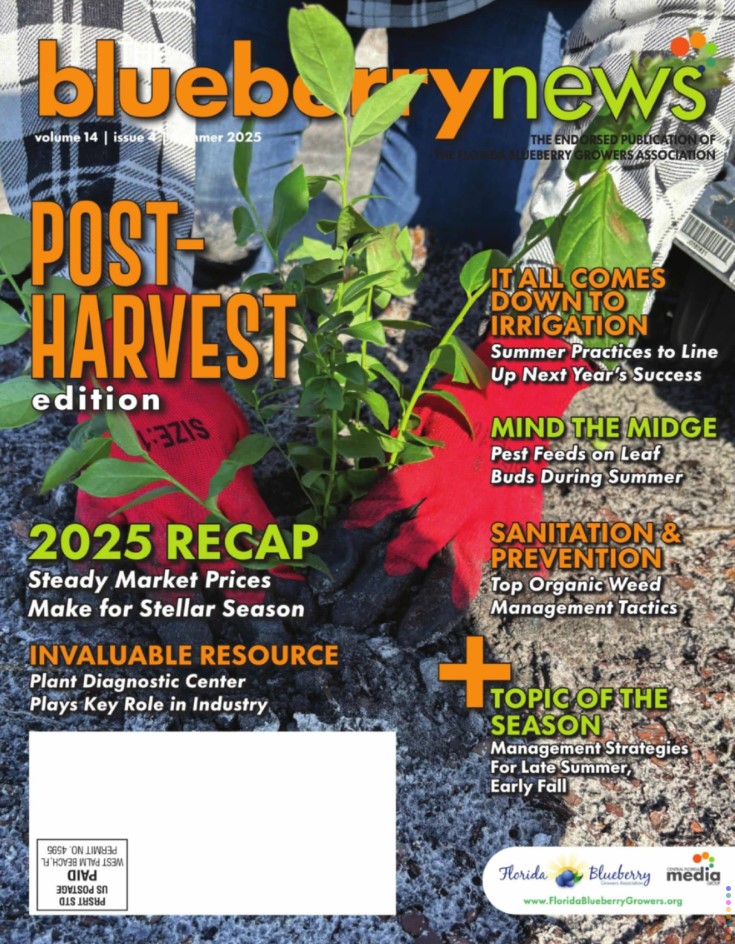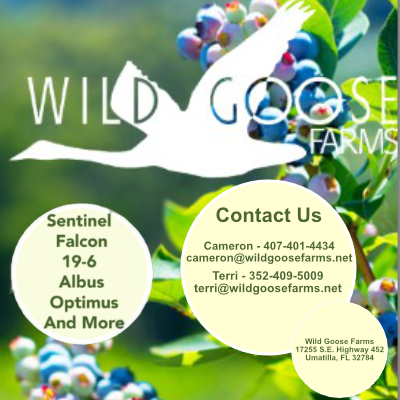Strategies for New and Mature Southern Highbush Blueberries
Pruning is a recommended practice in southern highbush blueberry (SHB) production. The many benefits of pruning include: maintaining and balancing vegetative and reproductive growth, reducing incidence of pests and disease, improving overall plant structure, controlling plant size, facilitating spraying and harvest practices, and reducing limb breakage, just to name a few.
Pruning may be done at different times of the year depending on the goals and objectives, but most routine pruning of SHB is done in the late spring, soon after the end of the harvest season. Delaying postharvest pruning until mid to late summer may reduce the number of flower buds that initiate on the regrowth that are needed for next year’s production. A major goal of postharvest pruning is to stimulate vegetative growth during the summer and establish a healthy, disease-free, canopy entering late summer or early fall, which is the major period for flower bud initiation (FBI) of SHB in Florida. Both shortened day lengths (long uninterrupted dark periods) and cooler temperatures stimulate FBI. These conditions occur during the transition to fall and early winter. The timing of blueberry FBI in Florida varies with cultivar and year but may begin as early as August on some cultivars and continues through late fall or early winter.
Research showed that “Emerald” FBI began in August while “Jewel” did not begin significant FBI until October. Leaves perceive the changing environmental conditions, so it is critically important that adequate new growth with healthy, disease-free leaves be present during this period to develop adequate flower buds for next year’s crop. Premature defoliation in early to mid-fall has been shown to significantly reduce the number of flower buds formed as well as the average number of florets within each flower bud.
Mature plants. As stated above, most pruning of mature plants is done soon after harvest is complete, giving as much time as possible for regrowth before terminal bud set in the fall. Generally, postharvest pruning is non-selective and done mechanically to reduce labor costs. Various types of mechanical pruners can be used to hedge and top blueberry plants (Photos 1 and 2).
Photo 1. Bennetts BTS chopper over-the-row mechanical hedger/topper. Jeff Williamson.
Photo 2. A flail hedger that cuts in one plane at a time is used here to prune riser rows. Jeff Williamson
Photo 3. A southern highbush blueberry field that was recently hedged and topped. Jeff Williamson
Topping height of a mature plant will vary considerably but generally will be between 40-48 inches, which allows for easy access to fruit during harvest. Many growers hedge straight across the top (Photo 3) but others prefer a “rooftop” cut angled about 45 to 55 degrees up to a point in the center of the plant canopy. Most SHB cultivars respond well to hedging and topping, however, there are exceptions such as “Chickadee,” which can struggle to achieve significant regrowth following hedging and topping. For “Chickadee,” light tipping instead of usual pruning has been beneficial in some cases. Alternatively, some cultivars tend to develop vigorous upright shoots in response to pruning. One or two follow-up tippings on vigorous upright shoots may increase branching and the amount of fruiting wood, but should be done in time to allow for regrowth to maturity before the fall/winter season. Crews may follow the mechanical pruning operation to “clean-up” (remove pruning debris, broken shoots, and diseased or damaged wood) and possibly “base prune” (remove one or two of the older canes near the crown) older plants. If mechanical harvesting is an option, efforts to keep the crown as narrow as possible are usually employed. Pruning cuts can be sites for fungal infections and pruning should be immediately followed with a broad spectrum fungicide spray (Photo 4).
Photo 4. A broad-spectrum fungicide spray is applied immediately after hedging and topping. Jeff Williamson
Photo 5. Regrowth of southern highbush blueberry following postharvest hedging and topping. Jeff Williamson
Pruning and training new plants. Traditionally, 1/3 to ½ of the tops of young blueberry plants are often removed at planting to minimize transplant stress and facilitate good plant establishment. The extent of pruning at planting will depend on the plant condition and the care that it receives following planting. Tall, leggy, or rootbound plants may require more top removal than smaller nursery plants. Historically, it has been common to remove flower buds from plants at planting followed by some flower bud thinning the following year depending on the extent of plant establishment in year one. In intensively managed fields of vigorous cultivars, and under the evergreen production system, growers have harvested fruit from young plants within the first 12 to 18 months after planting. Therefore, the extent of flower bud removal from young plants is dependent on cultivar, management system, and plant establishment.
Machine harvesting. Hand harvesting is the single greatest production expense for SHB. Many growers are considering machine harvesting as a more cost-effective alternative to traditional hand harvesting. Even if there are no immediate plans for machine harvesting, keeping that option open may be beneficial in the future. With current machine harvesting technology, considerable fruit will be dropped on the ground during harvest if plants are not trained to narrow crowns (Photo 6).
Photo 7. Recently planted southern highbush plants trained to a narrow crown with cartons. Jeff Williamson
Photo 8. Plastic sleeve used to train blueberry plants to have a narrow crown. Doug Phillips
If machine harvesting is an option, special consideration should be given to training plants to narrow crowns. This training should begin at planting. Juice or milk cartons are often used at planting to assist in training young plants to narrow crowns (Photo 7). Some growers have begun using plastic sleeves with fiberglass stakes, both of which can be reused (Photo 8). Once the cartons or sleeves are removed, some maintenance pruning will be required to maintain narrow crowns as plants mature (Photo 9).
Photo 9. These plants were trained to a narrow crown with cartons. The narrow crowns will increase harvest efficiency with machine harvesters. Jeff Williamson
Photo 6. A southern highbush blueberry plant that was not trained for machine harvesting. Note the large number of berries dropped by the harvester and the damage to canes from harvester catch plates. Jeff Williamson
Rejuvenation pruning. Older plants that have not been pruned for several years tend to lose vigor and become non-productive. If the plants are otherwise healthy, it is possible to rejuvenate the plants through aggressive pruning. All canes are cut back to 1 to 2 feet either in the late spring/early summer or during late winter just before they emerge from dormancy. If plants are low vigor due to overall poor health or a cultivar with low inherent vigor, rejuvenation pruning will probably not result in a positive outcome. Even with a successful outcome, rejuvenation pruning will likely result in a significant reduction in productivity for one to two years. Using rejuvenation pruning on only a portion of the field over a period of years will help maintain some level of productivity during the process.
For more information on pruning SHB in Florida, please see Pruning Southern Highbush Blueberry in Florida, https://edis.ifas.ufl.edu/pdf/HS/HS135900.pdf.
Credits:
Jeff Williamson, Horticultural Sciences Department, University of Florida
& Doug Phillips, Blueberry Extension Coordinator, University of Florida





